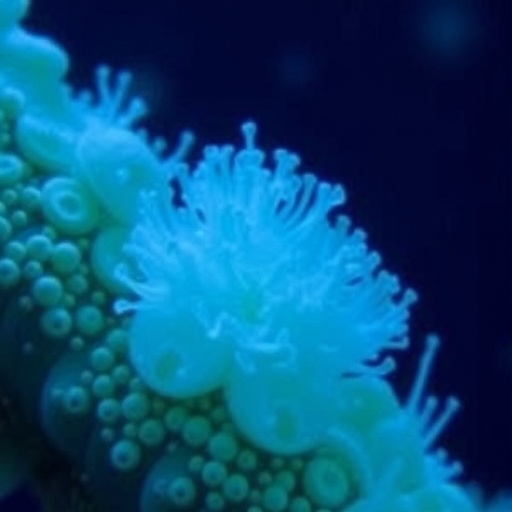Among the ocean’s smallest and most vital inhabitants resides a single-celled microbe known as Prochlorococcus. This cyanobacterium, often dubbed blue-green algae, represents one of the most abundant photosynthesizing organisms on Earth and underpins marine food webs far beyond its microscopic scale. It thrives predominantly in tropical and subtropical surface waters, accounting for approximately 5% of the planet’s photosynthetic activity. However, emerging research uncovers an unsettling vulnerability: the preferred temperature window of Prochlorococcus may be narrower than previously believed, posing dire implications as global ocean temperatures continue their upward climb.
For decades, oceanographers and microbiologists assumed that this tiny powerhouse of productivity would adapt seamlessly to warming seas, given its tropical affinity. Yet, new findings challenge this assumption, indicating that Prochlorococcus flourishes optimally within a narrow thermal band—roughly between 66 and 86 degrees Fahrenheit. Exceeding this temperature threshold severely impedes its cellular division, shrinking reproduction rates to merely one-third of those observed near the cooler end of its range. This thermal sensitivity places the cyanobacterium at significant risk as climate models forecast that many tropical and subtropical marine regions will routinely surpass these temperature limits within the next 75 years.
A pioneering study led by oceanographer François Ribalet at the University of Washington has offered the most comprehensive glimpse into how Prochlorococcus populations respond to ocean temperature gradients in situ. Departing from traditional laboratory cultures, the research team harnessed continuous flow cytometry technology—specifically, the SeaFlow instrument—to monitor billions of individual cells across an extensive global cruise network spanning 150,000 miles. This real-time approach allowed them to evaluate division rates and abundance patterns within natural seawater conditions, revealing the nuanced relationship between temperature and microbial productivity.
Remarkably, their analysis demonstrated that the rate of cell division was not solely dictated by nutrient availability or sunlight exposure, as once presumed. By systematically ruling out these factors, the researchers pinpointed temperature as the dominant determinant influencing cellular growth patterns. Importantly, the observed decline at elevated temperatures aligns with a lack of specific stress response genes in the organism’s streamlined genome—traits it evolved over millions of years to survive nutrient-poor tropical waters but which now limit its ability to cope with heat stress.
This genomic “streamlining” is a double-edged sword for Prochlorococcus. To thrive in oligotrophic, or nutrient-scarce, open ocean environments, it shed most non-essential genes, honing an efficient, minimalist genetic toolkit finely tuned to its niche. However, as the climate accelerates ocean warming, this evolutionary thrift deprives the organism of the molecular machinery needed to manage thermal stress effectively. Consequently, Prochlorococcus populations face a biological ceiling far below the temperatures anticipated in future ocean scenarios.
The decline of Prochlorococcus potentially heralds a cascade of ecological repercussions. This cyanobacterium is a foundational primary producer, generating organic material that fuels higher trophic levels—from microscopic zooplankton to massive baleen whales. A reduction in its biomass and productivity threatens to truncate nutrient and energy flow throughout marine ecosystems, fundamentally altering food web dynamics. The study predicts a contraction of Prochlorococcus populations in the warmest oceanic zones, with their spatial distribution shifting poleward as subtropical waters surpass thermal tolerance limits.
Intriguingly, the research also confronts the potential role of Synechococcus, another cyanobacterium with a more extensive genome and greater heat tolerance. While Synechococcus could partially compensate for Prochlorococcus losses, it requires richer nutrient conditions to flourish. The imbalance in nutrient needs and thermal niches between these microbes raises complex questions about how microbial communities and, by extension, entire marine ecosystems will restructure in response to climate change. It remains uncertain if the intricate ecological interactions engineered over eons involving Prochlorococcus can be replicated by its microbial competitors.
This study’s projections, grounded in climate modeling of greenhouse gas trajectories, suggest that under moderate warming scenarios, Prochlorococcus could experience a 17% decrease in productivity within tropical oceans, swelling to a catastrophic 51% loss under more severe warming paths. Globally, the declines range from 10% to 37%, an alarming indication of broad-scale impacts. Yet, the picture is not static; as polar regions warm, the cyanobacterium’s range is expected to expand poleward, potentially introducing novel biogeographical patterns and ecosystem configurations.
Despite the rigor and scale of this investigation, researchers acknowledge significant limitations. Sampling cannot encapsulate the entirety of Prochlorococcus diversity or all oceanic regions. Notably, the existence of undiscovered heat-tolerant strains within the population could mitigate some of the projected declines. The current findings represent the most parsimonious model given the available data, emphasizing the imperative for continuous exploration and genomic monitoring to unveil potential adaptive capacities that might provide resilience in warming seas.
The technological backbone of this research—the SeaFlow continuous flow cytometer—embodies a breakthrough in oceanographic microbial ecology. By harnessing laser-based detection of cell size and fluorescence in real-time seawater samples, scientists bypass significant artifacts introduced by lab cultivation. This innovation enables high-resolution tracking of microbial community dynamics along extensive cruise routes, generating unparalleled datasets critical for informing climate impact assessments.
Funded by the Simons Foundation alongside governmental and industry collaborators supporting MIT’s Center for Sustainability Science and Strategy, this research epitomizes interdisciplinary scientific enterprise necessary to address global challenges. It interlaces oceanography, molecular biology, climate science, and ecological modeling, forging pathways to anticipate and potentially mitigate forthcoming shifts in marine ecosystems driven by anthropogenic warming.
As ocean temperatures surge, understanding the fate of microscopic, yet ecologically monumental, organisms like Prochlorococcus grows ever more urgent. This cyanobacterium’s vulnerability underscores the fragility of foundational marine processes and the intricate dependencies woven through global biogeochemical cycles. The study lays a crucial foundation, prompting further inquiry into microbial resilience, evolutionary potential, and the cascading consequences of a warming ocean on the planet’s health and human well-being.
Subject of Research: Cells
Article Title: Future Ocean Warming May Cause Large Reductions in Prochlorococcus Biomass and Productivity
News Publication Date: 8-Sep-2025
Web References: http://dx.doi.org/10.1038/s41564-025-02106-4
References: Ribalet, F., et al. (2025). Future Ocean Warming May Cause Large Reductions in Prochlorococcus Biomass and Productivity. Nature Microbiology.
Image Credits: François Ribalet/University of Washington
Keywords: Cyanobacteria, Microbiology, Bacteria, Microbial diversity, Nutrient cycle, Marine biology, Marine photosynthesis, Food webs




